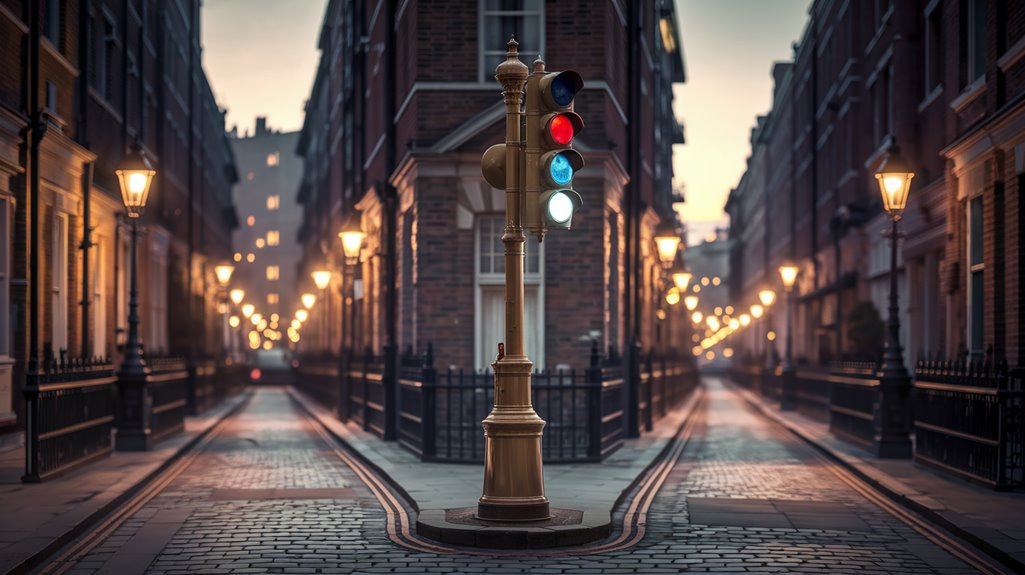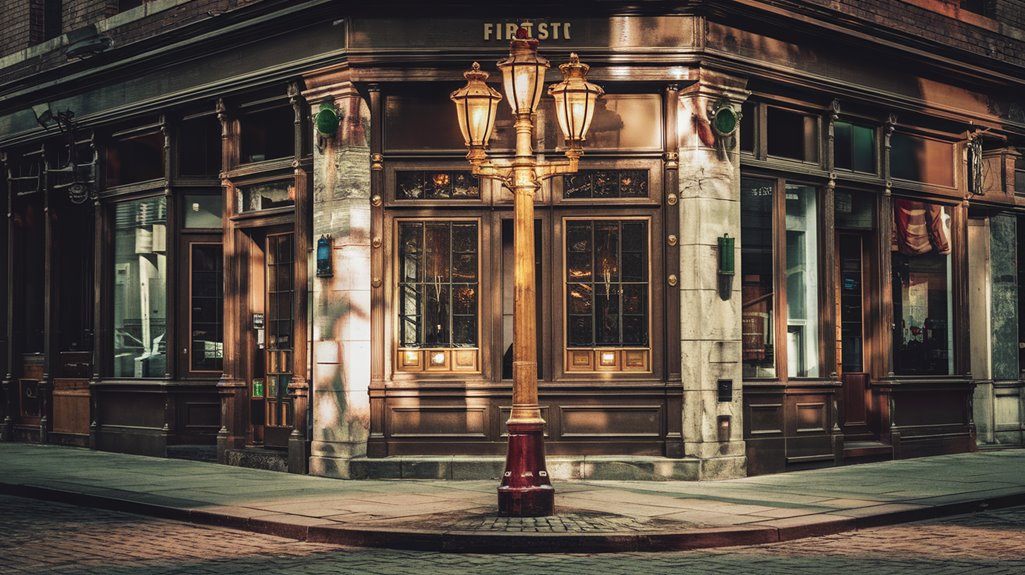The First Traffic Light Used Gas Lamps
You might not realize that the world's first traffic signal emerged from Victorian London's railway system, not its roadways. When J.P. Knight adapted railway signaling methods for street use in 1868, he'd created more than just a traffic device – he'd launched a revolution in urban safety. While today's LED signals operate flawlessly, this pioneering system relied on potentially dangerous gas lamps that would ultimately lead to its downfall, a story that showcases how even the best innovations can have unexpected consequences.
The Birth of Street Signals in Victorian London

While horse-drawn carriages dominated London's bustling streets in the 1860s, city officials recognized the urgent need for traffic control.
Before the signal's installation, three traffic officers directed the flow of vehicles at London Bridge.
In response to growing urban safety concerns, British railway engineer J.P. Knight proposed a revolutionary solution: the world's first traffic signal.
On December 9, 1868, Knight's Victorian traffic signal made its debut outside the Houses of Parliament.
Standing 22 feet tall at Parliament Square's north-east corner, this innovative device featured a cast-iron column adorned with gilding and acanthus leaves.
Railway signal engineers from Saxby & Farmer constructed the signal, which incorporated both semaphore arms and gas lamps for day and night operation.
A police officer manually controlled the device, using red and green lights to direct the flow of vehicles and pedestrians through this busy intersection.
Unfortunately, the signal's operation came to an abrupt end when a leaky gas pipe exploded in January 1869.
Engineering Behind Knight's Gas-Powered Innovation
Although electric traffic signals dominate today's streets, Knight's original gas-powered system represented a remarkable feat of Victorian engineering.
You'll find that gas lamp technology was cleverly adapted from railway signals to create a sophisticated traffic flow management system. The design featured a hollow cast-iron column topped with an octagonal box and decorative pineapple finial, combining both function and Victorian aesthetics. Gas street lamps had already revolutionized urban mobility by making nighttime travel safer for the public. The system stood six metres tall and required constant operation by police officers stationed at the intersection.
Here's what made Knight's innovation truly groundbreaking:
- Gas lamps provided essential visibility during nighttime and poor weather
- Manual semaphore arms controlled traffic at 45-degree angles
- Red and green lighting colors established a universal signal language
- The hollow column design efficiently housed the gas delivery system
Despite its short-lived operation due to a gas leak explosion, this invention laid the foundation for modern traffic control systems.
Day and Night Operation Methods
Knight's traffic signal operated through two distinct methods to manage London's bustling intersections around the clock.
During daylight hours, you'd see a police officer manually controlling three semaphore arms mounted on a 20-foot pillar. The semaphore effectiveness varied, as some drivers questioned the officer's authority, though The Illustrated Times noted surprising compliance from regular town drivers. This innovative design was created by railway engineer Knight and manufactured by respected signal makers Saxby & Farmer.
At night, you'd find red and green gas lamps housed in an ornate octagonal box atop the cast-iron column. However, gas reliability proved problematic. Parliament approved this groundbreaking traffic management system.
The lighting system often confused drivers and ultimately led to a devastating explosion in January 1869, injuring the operating officer. Despite these challenges and its eventual removal, this pioneering system laid the groundwork for modern traffic management, leading to the electric signals we use today.
The Unexpected End of the Pioneer Signal
Despite its promising start, the world's first traffic light met an abrupt and fiery end in January 1869. A gas leak within the hollow signal tower led to a devastating explosion, severely injuring the police officer operating it.
The explosion aftermath forced officials to remove the signal immediately, leaving London without traffic lights for the next 60 years. Designed by railway engineer Knight, this innovative signal had introduced a system of colored gas lamps to control traffic flow.
Here's what you should know about this historic incident:
- A faulty gas pipe caused the explosion by filling the tower with flammable gas
- The injured police officer had been manually operating the signal 24/7
- This accident delayed London's traffic light implementation until 1929
- The incident sparked crucial discussions about traffic safety improvements
The failure of this pioneering signal ultimately pushed engineers to develop safer, electric alternatives that would shape modern traffic control systems.
From Railway Inspiration to Urban Solution

When railway engineer John Peake Knight observed the effectiveness of train signaling systems, he envisioned a similar solution for London's chaotic streets. His railway technology expertise led him to design a pioneering traffic control device that would transform urban planning forever.
You'll find it fascinating that Knight's design borrowed directly from the railways, using familiar elements like semaphore arms for daytime operation and colored lights at night. The device utilized coal gas lighting, following the common practice of urban street illumination at the time.
The system was elegantly simple: vertical arms meant "go," horizontal meant "stop," while gas lamps displayed green and red signals after dark. Police officers were eventually freed from the dangerous task of manually directing traffic at busy intersections.
This innovative approach to managing city traffic earned quick government approval, leading to the installation of the world's first traffic light outside London's Parliament in 1868.
Knight's railway-inspired solution marked the beginning of modern traffic management.
Transforming City Traffic Management Forever
The installation of London's pioneering traffic light in 1868 marked a revolutionary shift in urban traffic management.
Though short-lived due to an explosion, this innovation laid the groundwork for modern traffic regulation and demonstrated how strategic urban planning could save lives in busy city centers.
The innovative signal system, designed by John Peake Knight, brought railway-style organization to London's chaotic streets.











